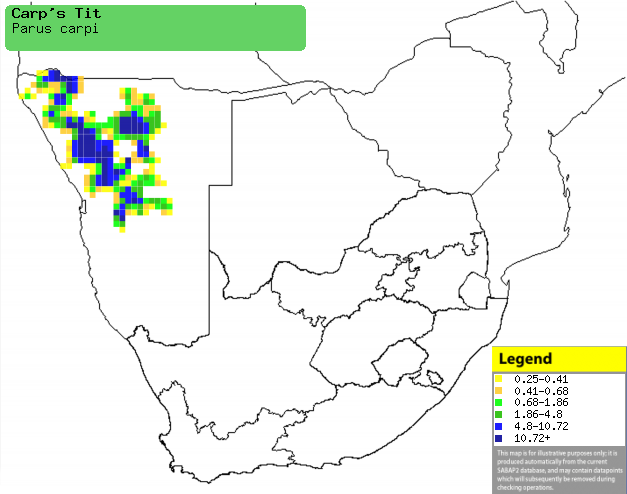|
Parus carpi (Carp's tit, Carp's
black tit)
Ovamboswartmees [Afrikaans]; Carp-mees [Dutch]; Mésange
de Carp [French]; Rüppellmeise [German]; Chapim de Carp [Portuguese]
Life
> Eukaryotes >
Opisthokonta
> Metazoa (animals) >
Bilateria >
Deuterostomia > Chordata >
Craniata > Vertebrata (vertebrates) > Gnathostomata (jawed
vertebrates) > Teleostomi (teleost fish) > Osteichthyes (bony fish) > Class:
Sarcopterygii (lobe-finned
fish) > Stegocephalia (terrestrial
vertebrates) > Tetrapoda
(four-legged vertebrates) > Reptiliomorpha > Amniota >
Reptilia (reptiles) >
Romeriida > Diapsida > Archosauromorpha > Archosauria >
Dinosauria
(dinosaurs) > Saurischia > Theropoda (bipedal predatory dinosaurs) >
Coelurosauria > Maniraptora > Aves
(birds) >
Order: Passeriformes > Family: Paridae
Distribution and habitat
It occurs from central to north-western Namibia, extending
marginally in to south-western Angola. It generally favours savanna woodland on
hills and escarpments, also occurring in dry riverine woodland and farmhouse
gardens.
|
 |
|
Distribution of Carp's tit in southern Africa,
based on statistical smoothing of the records from first SA Bird Atlas
Project (©
Animal Demography unit, University of
Cape Town; smoothing by Birgit Erni and Francesca Little). Colours range
from dark blue (most common) through to yellow (least common). |
Food
It eats mainly eats insects, often foraging in the lower
branches of trees, gleaning insects from leaves and crevices in bark. However at
certain times of the year its diet consists mostly of seeds.
Breeding
- The nest is a platform built of soft, fine material, placed in a natural
cavity of a tree.
- Egg-laying season is from November-January.
- It lays 2-5 eggs, which are incubated solely by the female for about
13-15 days. The male feeds her quite regularly, but she still has to go on
foraging trips once in a while.
- The chicks are brooded by the female, who also hands them the food that
the male gathers (he rarely gives it to them directly). They stay in the
nest for about 18 days, becoming self-sufficient a few days later.
Threats
Not threatened.
References
-
Hockey PAR, Dean WRJ and Ryan PG 2005. Roberts - Birds of
southern Africa, VIIth ed. The Trustees of the John Voelcker Bird Book
Fund, Cape Town.
|
